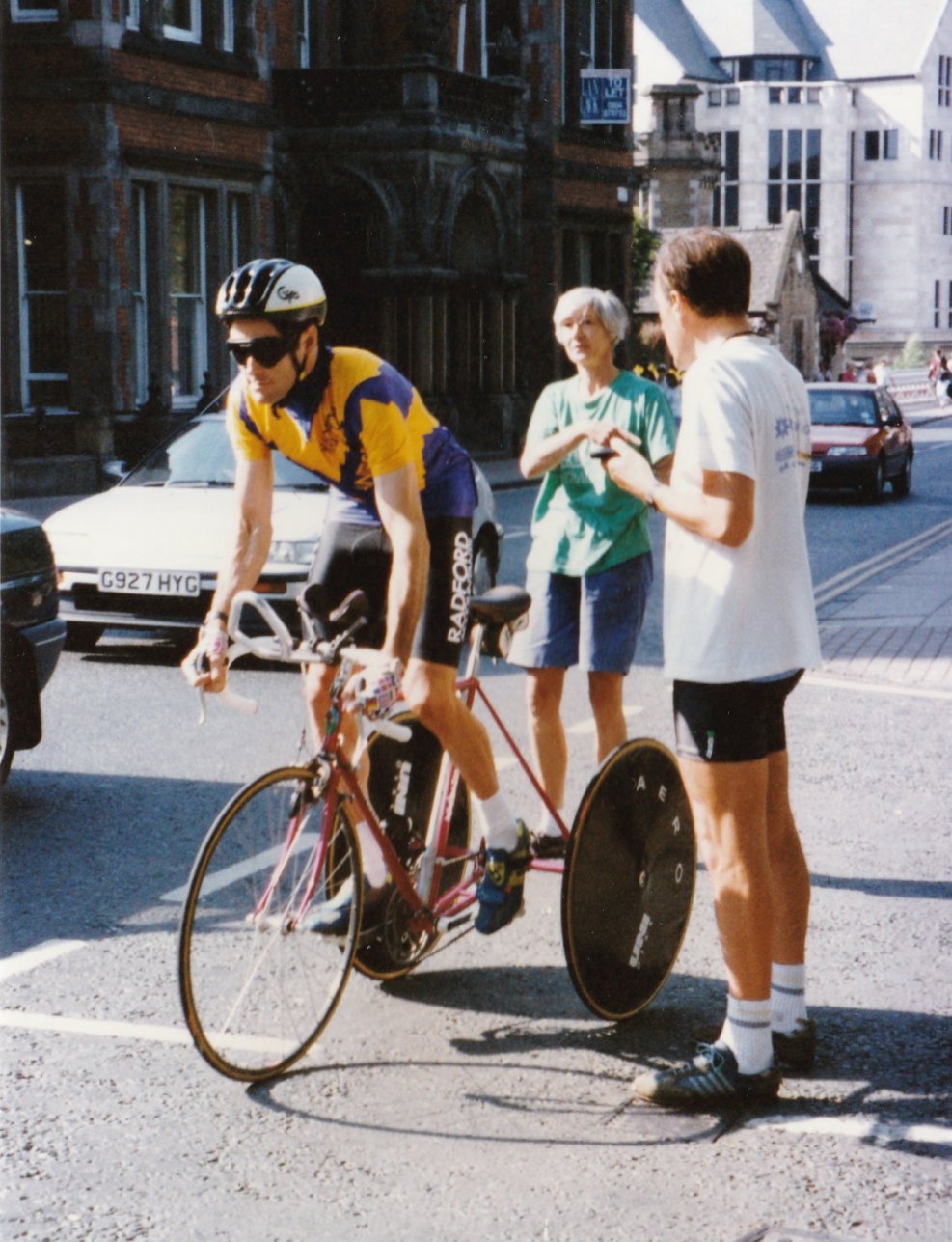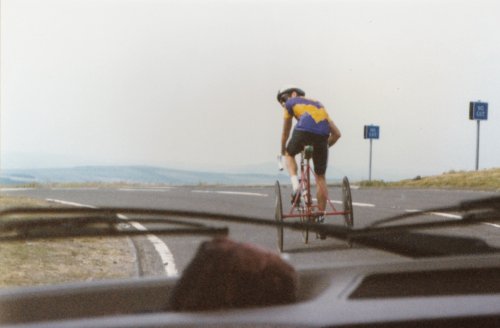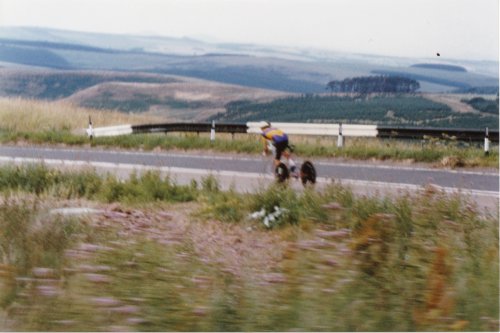www.dadswell.co.uk Mostly cycling records, mostly on three wheels
The Final Scottish Adventure?
Ralph Dadswell, Aug 96
In the time honoured style, after weeks of waiting, something
interesting appeared on the weather charts.
On 31st July, the prognosis for Monday 5th August was for
south-easterly winds in the north of England.
Of course, you shouldn't get too excited when looking that far ahead, as
slight changes can mean (from the record-breaking point of view) that
the conditions become useless.
However, the charts which arrived on each of the following two
days still indicated that the York to Edinburgh tricycle record was
possible for the Monday.
By Saturday I had decided to make the attempt, and needed to assemble a
team. Martin Purser agreed
to be in the car, and Hedley Stennett was soon confirmed as Timekeeper.
After a number of phonecalls, I hadn't found a willing third
person, but luckily Alison Purser stepped in to complete the team.
All we had to hope for was that the weather would remain suitable.
John Dalton had cautiously approved my analysis of the charts,
but pointed out a number of factors which could alter the eventual
result. It was quite
possible for the predicted scenario to occur somewhat earlier or later
than expected, and of course something might happen to prevent it
occurring at all! Fingers
were crossed as the fax machine ejected Saturday evening's charts.
Luckily, despite the overall picture taking a different
appearance, the isobars affecting the York to Edinburgh course were
suitably placed, and the all-important cold front was still placed to
the west of Ireland. All
systems go.
On Sunday afternoon I drove to the Purser residence just north of
Newark. At 0730 on Monday,
the laden BMW saloon set off for a 1000 start in York.
The tricycle record from York to Edinburgh was set in 1963 by John
Arnold. In the previous
couple of years, two other tricyclists had been 'teasing' the record,
bringing it down in three stages from 10h 28m to 10h 4m 24s.
The celebrated Mr Arnold chose his day, and took 75 minutes off
to leave a revised target of 8h 48m 28s.
I suspect that this time scared everyone off for quite a while.
I have read a report on the ride, and it refers to the following
car being unable to keep up with the rider, who was being assisted by a
"howling gale". I was
hoping for a favourable wind, at about 15 mph, persisting throughout the
ride.
Herbert Dixon was waiting at the start, and John Wood appeared a little
later. As 10am approached,
they left us, to allow them to witness my progress out of the city.
With 5 minutes to go, I was ready.
Unfortunately, York had decided to grid-lock itself.
We considered our options to delay the start, but luckily things
began to move, with literally just seconds left.
I set off on time, but the first mile was not quick.

(photo Martin Purser. Hedley sets me off, Alison Purser
shields from behind.)
The second mile was not without its problem either.
I was happily riding along, when suddenly I felt a sharp pain on
my right forearm. I looked
down to see a wasp, which was probably rather pleased with itself.
Brushing the insect away, I reflected that this was scarcely the
ideal way to start a long ride - with an injection of poison!
Fortunately, I don't suffer badly when stung by wasps or bees, and I
decided to ignore the irritation.
I managed to do this for about 15 minutes, before indicating to
the following car that I needed assistance.
My gesticulations were sufficiently graphic for the First Aid box
to be ready for me after they had overtaken and parked.
Treatment involved application of anti-inflammatory cream.
This didn't seem to do an awful lot, and I've since been advised
that it won't have done anything at all.
However, my mind was a little more relaxed.
The terrain north of York is really flat, and my progress was good.
By Thirsk, I was 4 minutes ahead of schedule, and by Darlington I
was 8 minutes in front. It
occurred to me that either a) I was going to demolish the record in
spectacular style, or b) things were going to get horrible after I had
passed the River Tyne. I
suspected the latter, but tried to keep my mind positive.
Along the Durham bypass, conditions are a little undulating, and any
further gains were put on hold.
I overtook Dave Turner as I approached Chester-le-Street.
He had been intending to act as a marshall at a strategically
important point, but was about 1 minute late.
I managed to take the correct route, and thought no more about Dave.
What I didn't know was in his efforts to shout instructions to
me, he hadn't taken enough notice of other traffic on a roundabout.
Luckily, the Ford Escort had almost stopped by the time of the
collision. Luckily, Dave
was able to pick himself up off the deck and wheel his tricycle to the
side of the road.
Unluckily, he might get a bill for his trouble.
I was still hanging onto an 8 minute advantage when I joined the A1
Newcastle Western Bypass.
What a bit of road this is.
Immediately the speed was up to 30 mph and adrenaline was bubbling.
On one descent I overtook a Nissan Micra, and sneered in at the
occupants as I eased past.
"Oooh look, there goes a man on a, ...... a TRICYCLE!"
The only snag with this bit of road is that it can be split into two
very distinct parts. The
fast fast fast descent to the Tyne crossing, and the slow slow slow
climb away from the river.
Once past the nadir, the speed was transposed from 41 mph to 14 mph.
This was also a section where the wind was quite unhelpful.
The principal problem, however, was the large number of sliproads
on and off, with very short weaving distances.
Couple this with very heavy traffic, and you end up with an
enormously stressful time (even worse for those in the following car,
trying to protect me).
To the relief of everyone, I eventually reached the exit for Jedburgh,
and was able to rejoin a peaceful road, with the wind behind me again
(and I’d gained
another 2 minutes).
I started seeing signs showing the distance to Edinburgh.
I really should know better, but I believed them.
The predicted final distance went up from 186 miles to 188,
rather disappointingly.
Conditions were comfortable for a while, and 100 miles was passed in 4h
22m.
At this point, I was running 14 minutes ahead of schedule, having gained
4 minutes since leaving Newcastle.
This should have made me feel good, but all that really happened
was that I became less and less satisfied with my scheduling.
My earlier suspicions had been that things could get nasty in the
last 4 hours. I was sure
that my speed assumptions were flawed, and that how ever I felt, I was
going to lose time in the hills.
It is perhaps no coincidence that, whilst thinking about this, I
was ascending the first of a series of 1000 ft obstacles.
I stopped briefly for a wash down, as the sun had been out for most of
the day, leaving me a bit uncomfortable.
As I stood beside the road I noticed that there was quite a good
breeze which was helping me along.
This was motivating as I set off again, and I started to believe
that I could still get to the finish on time.
There were some exciting alpine-style curves in the descent
towards Otterburn. My
thoughts, though, were that all these fast downhill runs were a terrible
waste of all the altitude that I had fought for ages to gain.
I was just over the speed limit as I entered Otterburn, and was
hanging on to a 13 minute advantage as I joined A68 at Elishaw.
I was now retracing the route which I had used when I broke the
Edinburgh to London record in 1991.
My recollection of the next few miles was that it had been twisty
and rather lumpy. This
proved to be accurate, and 20 mph was a rarely seen speed.
With the prospect of two major climbs before the finish, I was
unhappy to be struggling on what should have been a reasonably palatable
stretch.
As I took on a fresh bottle near the Catcleugh Reservoir, I had mixed
emotions. On the one hand,
I knew that I only had 3 miles to the Carter Bar summit.
However, I also knew that the hard work was only just beginning.
Once the lake is passed, the scenery disappears, and it's just
you, with the road for company.

After a long time, there is a sign indicating that the viewpoint is 1
mile away. I was holding 12
mph, and so I only had another 5 minutes of leg breaking effort to go.
Hours later, another sign came into view, almost.
It again referred to the viewpoint, and gave the distance in
yards. Due to some long
grass, I couldn't see how many yards, but guessed that it had to be
about 200. Imagine my
disappointment to eventually see that there were 450 yards to go.


With the border in sight, I raised my speed, and tried to look anything
but shot-to-pieces as I passed the crowd at the summit.
The crowd continued to admire the scenery (and the sound of the
piper), and totally ignored me.
Oh well.


So, having fought my way up to 1370 ft, I then surrendered nearly half
of that in the next two miles of thrilling descending.
On the outside of one right-hand bend, there was a van parked.
This meant that I was forced to take an even tighter line than
normal. Had there been
time, I would have said my prayers; luckily, there was no oncoming
traffic.
As I approached Jedburgh, I recognised the 50 mile point from the
Edinburgh-London ride. This
was at a time when the roadsigns had persuaded me that there were only
49 miles left. Damn.
At Jedburgh, I had regained the time lost climbing Carter Bar.
There were 47 miles left (maybe), and 2h 32m before the time ran
out. Even ignoring the
climb at Soutra, the remainder of the ride is on challenging terrain -
particularly if you're getting tired.
I was then looking out for Earlston.
There was a sign which said "Earlston 3", and then (several
minutes later) there was another "Earlston 3".
I checked to see that I didn't have a traction problem, but
everything seemed to be fine.
This might have been a slow section, but 5 minutes later, there
was a sign indicating 2 miles to Earlston.
When my quarry was finally reached, I had covered more than 2
more miles, and was down to an 11 minute advantage.
The only bright part about Earlston was the unexpectedly good news that
there were only 33 miles to go.
I was a little suspicious, as this was 2 miles fewer than I had
conditioned myself to have to endure.
Two miles later, though, there was a "31 miles" sign, so maybe it
was right.
As I passed through Lauder, I was amazed to see that there were only 25
miles left, so this meant that from the top of Soutra I would have just
16 miles to go. Incredible.
A few miles later, I once again waved civilisation goodbye, and moved
back into climbing mode.
Towards the end of the giant ramp that takes you to the top of Soutra
Hill, the following car went past.
When the road had levelled out, I took a fresh bottle and coasted
along, relieved to be still 7 minutes ahead of schedule, with lots of
descending ahead of me.
But hang on a minute, I've been ripped off here .... this isn't the top
after all - there's another bit!
To say I was unhappy would be understating the case somewhat.
However, this bonus section wasn't too bad, and I eventually
passed the summit with 4 minutes to spare, over my unsympathetic
schedule.
Hopefully, I could pull back some extra time in what could only be 16
miles before the finish. Oh
dear, that roadsign just said 17 miles, didn't it.
Maybe my original measurements were right, after all.
With a few exceptions, the run along to Pathhead was quite quick, but
things weren't so good on the approach to Dalkeith.
This was probably not helped by an "Edinburgh 11" sign appearing
when I was confidently expecting "Edinburgh 10".
When you're that close to the finish, an extra mile is a big
deal.
However, some traffic disruption in Dalkeith kept me alert, and then I
was into the last knockings.
I was quite fortunate with lightish traffic at the Edinburgh ring
road, and then just tried to sell myself before reaching Princes Street.
Even as you approach the city, the road still twists and rolls.
It was a real effort to keep even to 20 mph.
On cue, I passed the Commonwealth Pool, turned left, then right,
and was on the final run in.
With the record all but in the bag, I cautiously made my way through the
unpredictable city-centre traffic.
I wound up the speed for the final uninterrupted section over the
North Bridge, and prepared for the finish.
Hedley was there (having
previously been whisked ahead in Bill Nimmo's car), and I approached him
at maximum speed.
With a few yards to go, I then gave some thought to how much space there
was available for slowing down after the finish point.
About 10 feet, before you hit Princes Street.
I can't remember another occasion when I've passed the timekeeper with
my brakes on. However, the
lights were red, and there were vehicles crossing the junction.
I stopped in time, but it was exciting!
The official time was 8h 39m
43s, which is 8m 45s faster than John Arnold.
Within a couple of minutes
Martin and Alison arrived with my car, and there was soon an excited
throng of people around me.
The most excited was a German tourist, who had great difficulty in
understanding why anyone would want to pilot a tricycle, let alone to do
so for 300 kilometres. Not
content with a few minutes of chattiness from me, he insisted on
continuing to ask strange questions and offer his curious opinions.
This was despite my rather obvious efforts to clean myself up and
get some different clothes on.
Eventually, he moved on, but only as far as Alison.
She humoured him for a fair while longer, and I was left with a
combination of feelings of amusement and guilt.
When I phoned HQ to tell Mum and Dad the result, I had been beaten to it
by the efficient Carole Dietman.
She had made her fifth call of the day, and was probably saying
goodbye as I was dialling.
I had first seen Carole just before Dalkeith, and we had exchanged
beaming smiles. I don't
think I could have managed that if I'd been struggling up a hill!
With all the gear in or on my car, our day wasn't finished yet.
I had made the offer of arranging overnight accommodation
somewhere on the road to the South.
However, Martin and Alison had reasons for wanting to get back to
Newark in one go. I am
pleased to announce that I wasn't expected to play a part in this insane
idea, except to fill the car with fuel.
Martin started the 230 mile epic journey, by driving to Berwick, where
we had a food stop. At this
point, Alison took the wheel for the remaining 180 miles.
She had deliberately taken a low-key role during the attempt, to
be ready for this challenging task.
Let me state clearly that it's not something I would ask anyone
to do!
At 1am, we reached our destination in slumbering Grassthorpe, and were
greeted by a sleepy Pippa.
By 2am I put down the book of Helms cartoons, and nodded off.
Later that day, I polished off the final 130 miles home, broken up only
by a stop at McDonald's in Wyboston.
Aren't cheeseburgers the food of the Gods?
The margin over the previous, 33 year-old, record was not giant.
However, it seems as though John
Arnold had a very good day, perhaps in the same league as David
Duffield's day for the London to York ride.
With this in mind, and the likelihood that 90% of the course will
have been on the same roads, I'm fairly happy with my time.
This ride means I've completed the set of all five record routes linking
London with Edinburgh - via Liverpool and York, and of course directly.
As I write this, it seems that I won't fit in a "Brighton & back" this
year, but there's still a chance for Land's End to London.
If it comes off, it would be record number eighteen.
Watch out, Mr Pitt!